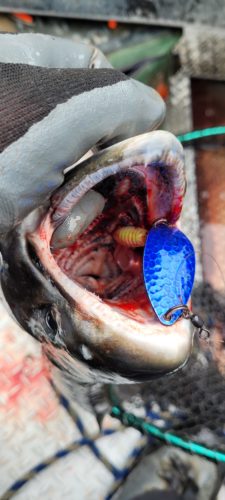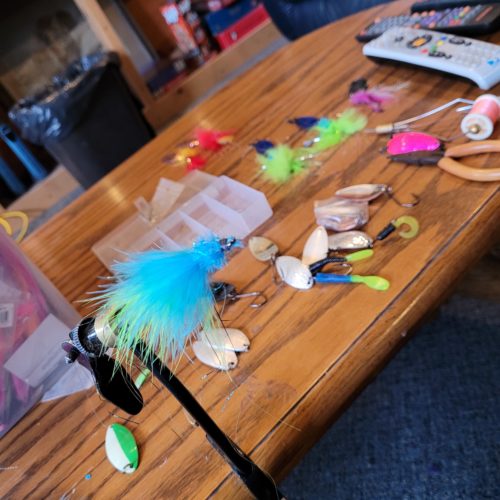
Situk River “Add-Ons” To Spoons, Spinners Tempt Silvers

The following appears in the August issue of Alaska Sporting Journal:
BY RANDALL BONNER
Casting and retrieving spinners and twitching jigs are pretty standard approaches for targeting coho.
But the versatility of spoons allows anglers to combine elements of metal and fur from both tactics to catch fish that have often seen the same two techniques again and again.
Fished with a steady retrieve, drift and/or a few twitches in the mix, the combination of flash with the erratic movement of natural materials are the best of both worlds. Given that there are always circumstances in which a spinner or twitching jig are better options, a spoon can effectively target coho in some situations that aren’t fishable with other conventional methods.
The variety of components available to customize spoons allows the lure to be fished in different environments with different depths and current speeds. When throwing into brush, having a single hook on a split ring with the point facing up from the concave side of the spoon allows the slow wobble from side to side to slide over limbs without snagging up, making it a deadly presentation for the mangrove of willows and timber that makes the Yakutat’s Situk River known for its incredible coho habitat.
HEAD ON A SWIVEL
Swivels are a necessary component to building a spoon, but different configurations serve different purposes. While a swivel on the tail end of a spoon attached to a hook may help prevent a spinning coho from spitting the hook, it does very little for line twist during your retrieve. A swivel built into a split ring on the top of a spoon will help prevent line twist while minimizing the profile of the components. A snap swivel is a slightly larger component, but allows an angler to swap out presentations faster and more effectively. The usefulness of this feature will become evident when a noticeable difference in environmental conditions (sunlight, water clarity, etc.) occurs, turning the fish off to one color and on to another with a brief moment to make those game-changing decisions.

SHALLOW WATER HAZARDS
Coho that are resting in the current breaks of brushlines are often settled into very shallow areas with lots of potential snags. These areas hold lots of fish that see very little pressure because they’re difficult to target with conventional methods of twitching jigs, spinners and even spoons.
Twitching jigs fall into the zone quickly, but shallow water leaves very little room for their range of motion, which is reduced even more by the presence of snags. A spinner may be more effective in this kind of water, but if the fish are tight to the bank, the effectiveness of the action from a spinner is reduced from the moment it hits the water until the retrieve begins the spin of the blade around the body.
Sometimes, getting the blade to turn over requires those first few cranks of the reel during the first few feet of your retrieve, meaning you’re not actually fishing effectively until you’re beyond the strike zone of those fish hanging tight to the brush along the banks. Fished alone, a spoon has a very limited range of motion with a very tight wobble and sinks much faster, meaning it’s probably going to find snags before it finds a biter.
’ADDING’ IT ALL UP
Beyond snaps, swivels, split rings, hooks, and configurations, add-ons that turn the spoon into an articulated/jointed profile not only create a deadly presentation that will draw the attention of finicky biters and pressured fish, but change the sink rate and action of the lure so you can fish areas that other anglers avoid all-together.
One example of a popular add-on to a metal presentation is a hoochie squid, especially when it comes to spinners. Even with the tight rotation of the blade, the wire body and hook built into these lures will spin. The addition of a hoochie skirt will provide colorful movement to the flash of the blade, with the rotating tentacles spinning like the bristles on a drive-thru car wash or a tutu on a dancing ballerina.
Hoochie skirts move a little differently on a spoon, but they create a wider, more erratic articulated side-to-side motion, like a kokanee dodger that can be fished at a much slower retrieve, or jerked and twitched midretrieve to make it turn over. Using a hoochie in combination with crystal flash or tinsel will reflect more light from the full profile of the lure, while the addition of darker colors can create a presentation with more contrast.
Tying hoochie skirts on a hook with a vise before building them into a split ring on the tail end of a spoon will not only prevent them from sliding down the hook, but allow you to be creative with your add-ons (more on that later).

PLASTIC POWER
One of the most simple add-ons for hardware is soft plastics. They’re easy to thread onto the hook and remove to replace or change presentations, which might be their best and worst attributes. Most soft plastics don’t hold up quite as well as the plastics from a hoochie squid and need to be frequently replaced. Different shapes and styles of soft plastics create different movements. For example, a trimmed-down steelhead worm might create more subtle articulated motion and a faster fall than the resistance from a curly tail grub.
While I’ve fished jetty spinners with hoochies for Chinook, I never really dove too far into experimenting with soft plastics on hardware until I did a season of guiding for coho on the Situk. Back home, I had plenty of success targeting coho on spinners on coastal rivers, and adding anything else to them seemed like overkill.
One day, a client was leaving Yakutat on a jet and asked me if I wanted a few packs of curly tailed crappie grubs from Bass Pro Shops he was planning to leave behind.
“I’m not sure how I would use those, but it’s hard to resist free tackle, so sure; I’ll take em!”
A few days later, I was fishing spinners during what seemed to me like a slow bite until I kept passing other guide boats that were roping in fish. I paid close attention to what they were using, and to my frustration, all of them were throwing spinners too. This made me question what they were doing differently that was working for them but not for me.
I began to notice that I was the only guide without a hoochie on my client’s spinners, and also realized I didn’t have any in my tackle box. What I did have were those crappie grubs given to me by a client a few days ago, and nothing to lose by giving them a try.
I found myself in somewhat of a survival situation that made me recall a quote by Theodore Roosevelt: “Do what you can, with what you have, where you are.”
I grabbed a crappie grub with a black body and chartreuse-tail, which was the same color pattern as my most effective twitching jig that week, threaded the soft plastic on the hook of a chrome spinner and sent it into battle. That became my “ah-ha moment.”
My so-called “luck” changed almost immediately and turned the second half of the day into an action-packed afternoon of catching coho. I never threw another naked spinner the rest of that season.

SPOON MAGIC
Another part of this learning curve happened when I was having a conversation with a client who had been having luck on a spoon with a hoochie that I found in a snag and tied onto the lure. The angler had otherwise been struggling to get their spinner to turn over with the slow and erratic retrieve the situation called for.
I explained how the action of the spoon actually made it easier to fish in certain situations, like shallow-water brush lines. Enthusiastic about wanting to try throwing the spoons he had brought, he reached into his tackle box and tied one on but without a trailer, tossing it into a shallow brushline at a visible group of fish.
We watched his spoons sink like shiny rocks and get caught in snags. Recalling that I still had all those crappie grubs, I threaded one on a spoon for him and it was like hitting a switch. The sink rate of that spoon changed drastically and the bite was on again.
Another difference I noticed fishing metal was that fish would often violently strike a spinner during a retrieve and immediately spit it out while the clients never even knew there was a bite. Once I began to add soft plastics to metal, I observed multiple occasions where the fish not only chomped the presentation, but completely inhaled the hook with the soft plastic trailer beyond their gills, which is something to consider for catch-and-release fisheries.
Regardless, they stopped spitting out the spinners and allowed more time for clients to react. Soft plastics are less durable and typically only useful for a fish or two before they begin to slide down the hook, but they are convenient to replace or change color combinations on the fly.
Marabou, tinsel, chenille, rabbit fur and other fly-tying materials can be tied onto a hook with a vise for a more permanent solution that is a little more aesthetically pleasing. These materials will add additional color and flash to the profile, but with less resistance than soft plastics when moving through the water column for a tighter wobble and a faster sink rate that doesn’t compromise the size of the profile and its articulated motion. The erratic movements are a little more sharp and fish better with a faster retrieve or with more twitches and jerks. When tying materials to your hook, bear in mind that they will be matted down once they’re wet. Long pieces of marabou will be thin and extend well beyond the hook, which along with the fact it will taste like a mouth full of feathers, might create more potential for short bites.

CHOOSE THE RIGHT COLORS
Regardless of what you add, color combinations can really come into play with varying conditions. When creating color schemes, you might want to think in the same terms of your selections for twitching jigs and spinners. On sunny days, when you might reach for a chrome spinner or a black and chartreuse twitching jig, a chrome spoon with a black body and chartreuse tail grub is a go-to combo.
While fishing with fellow writers Dave Vedder and Scott Sauder on the Situk, I was excited to show them the pattern that had been working so well for me that week, but in the afternoon clouds rolled in and the bite died. Dave mentioned he liked throwing brass, gold, and copper on cloudy or rainy days, so I pulled out a copper spoon with a red/ orange/yellow flame pattern tied on the hook with marabou, rabbit fur and tinsel that I hadn’t tried yet and found success.
On similar days with similar conditions, a copper spoon with an orange curly tail grub did well for me, even when visibility wasn’t ideal. A white-chrome-patterned R&B spoon with a trimmed-down section of a Seahawk-pattern Western Fishing Operations worm on the hook seemed to work well when nothing else would. On partly cloudy days with lots of light in low, clear water, black spoons with pink trailers, pink chrome with purple trailers, and blue chrome with chartreuse trailers also seemed to work well.
These additional luxury options to the standard configurations will expand the possibilities and opportunities for catching more fish. Understanding the tactical versatility of add-ons for spoons makes spoon-feeding silver salmon a bowl of fun! ASJ



